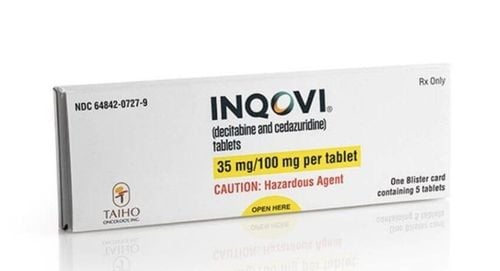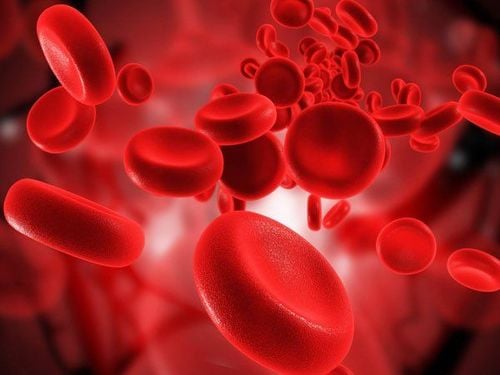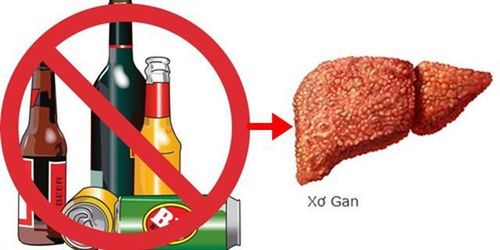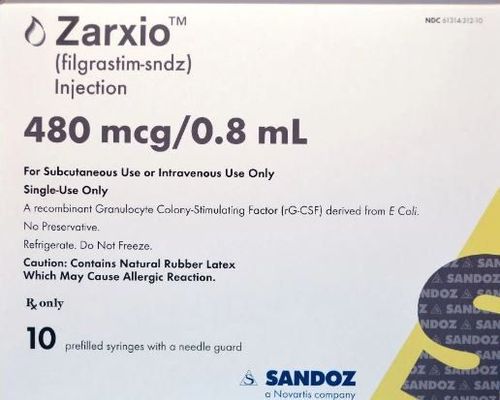This is an automatically translated article.
Myelodysplasia (also called myelodysplasia) occurs when the stem cells in your blood fail to become healthy blood cells. Medullary dysplasia can cause serious conditions such as anemia, frequent infections, and bleeding that doesn't stop. Treatment of MDS focuses on slowing the progression of the syndrome, treating the associated conditions, and alleviating symptoms. This article will take a look at the stages and treatment of myelodysplastic syndrome (MDS).
1. What is myelodysplastic syndrome (MDS)?
Myelodysplastic syndromes (MDS) are conditions that can occur when the blood-forming cells in the bone marrow become abnormal. This results in low counts of one or more types of blood cells. MDS is also considered a type of cancer.
Bone marrow is found in between certain bones. It is made up of hematopoietic cells, fat cells, and supporting tissues. A small portion of hematopoietic cells are blood stem cells. Stem cells are needed to make new blood cells.
In MDS, some of the cells in the bone marrow are not normal (dysplasia) and there is a problem with making new blood cells. Many of the blood cells made by these bone marrow cells are defective. Faulty cells often die earlier than normal cells, and the body also destroys some of the abnormal blood cells, leaving the person without enough normal blood cells. Different types of cells may be affected, although the most common finding in MDS is a lack of red blood cells (anemia).
There are several different types of MDS, based on the number of affected blood cell types and other factors.
In about 1 in 3 patients, MDS can progress to a rapidly growing bone marrow cell cancer called acute myeloid leukemia (AML). In the past, MDS was sometimes called pre-leukemia or smoldering leukemia. Since most patients do not have leukemia, MDS was once classified as a disease of low malignancy. Now that doctors know more about MDS, it is considered a form of cancer.
2. Symptoms of myelodysplastic syndrome (MDS)
Usually, there is no sign of MDS but there will be variation in laboratory values. If a person has signs of MDS, it is related to a low blood count and can include:
Low red blood cell count can make a person tired, pale, chest pain and feel dizzy . A low platelet count can lead to bleeding, petechiae (small red or purple dots under the skin), and bruising. A low white blood cell count can also lead to an infection. Over time, myelodysplastic syndrome can cause:
Fatigue Shortness of breath Unusual pallor (pallor) and occurs due to a low red blood cell count (anemia) Unusual easy bruising or bleeding and occurs due to a low blood platelet count (thrombocytopenia) Correctly sized red spots just beneath the skin due to bleeding (petechiae) Infections are frequent and occur due to a low white blood cell count (leukopenia)
3. Causes of Myelodysplastic Syndrome (MDS)
For a healthy person, the bone marrow makes new, immature and mature blood cells over time. Myeloma occurs when something interrupts this process and causes the blood cells to fail to mature.
Instead of growing normally, blood cells die in the bone marrow or shortly after entering the bloodstream. Over time, there are also more immature, defective cells than healthy ones, leading to problems such as fatigue due to too few healthy red blood cells (anemia), infections caused by too few white blood cells are healthy (leukopenia) and the bleeding is caused by too little clotting of platelets (thrombocytopenia).
Most myelodysplastic syndromes will usually have no known cause. Others are also caused by exposure to cancer treatments, such as chemotherapy and radiation, or to toxic chemicals, such as benzene, alkyl drugs, viruses, certain genetic diseases and the aging process of old age.
4. Types and stages of myelodysplastic syndromes
4.1. Types of myelodysplastic syndromes The World Health Organization divides myelodysplastic syndromes into subtypes based on the type of blood cells - red blood cells, white cells and platelets - involved.
Types of myelodysplastic syndromes include:
myelodysplastic syndromes for single-line dysplasia. One type of blood cell - white blood cells, red blood cells, or platelets are also low in number and appear abnormal under the microscope. Myelodysplastic syndromes with polyglandular dysplasia. In this subtype, two or three types of blood cells are abnormal. Myelodysplastic syndrome with lateral ring myeloblasts. This subtype will involve low counts of one or more types of blood cells. A key characteristic feature is that the red blood cells present in the bone marrow contain excess iron rings. Myelodystrophy syndrome for a distinct del (5q) chromosomal abnormality. People with this subtype will have low red blood cell counts and cells with a specific mutation in their DNA. Myelodysplastic syndrome for excess blasts. In this subtype, any of the three cell types — red blood cells, white blood cells, or platelets — can be low and appear abnormal under the microscope. Very immature blood cells (blasts) are also found in the blood and bone marrow. myelodysplastic syndromes, unclassifiable. In this subtype, the number of one or more types of mature blood cells is reduced and the cells may look abnormal under the microscope. Sometimes the blood cells appear normal, but analysis may show that the cells have DNA changes that are associated with myelodysplastic syndromes. 4.2. Stages of myelodysplastic syndromes For most cases, staging or staging the cancer helps determine treatment options. Because MDS is a bone marrow disease, prognosis is not based on the size or extent of distant metastases like other cancers.
Instead, MDS is based on a variety of factors. A scoring system, the International Prognostic Scoring System (IPSS-R) was adjusted, based on the following factors:
The percentage of immature blood cells (the very early form of blood cells) found in bone marrow Type and amount of chromosomal abnormalities found in cells Red blood cell count in the blood Platelet count in the blood Neutrophils (a type of white blood cell) in the blood Each score 1 point, The lowest total score corresponds to the best prognosis. Add the scores for all factors that determine the patient's risk group:
Very Low Risk Low Risk Moderate Risk High Risk Very High Risk Another scoring system, the scoring system World Health Organization (WHO) criteria are based on the following 3 factors:
MDS type based on WHO classification Chromosomal abnormalities (grouped as good, moderate or poor) Whether frequent blood transfusions are needed With IPSS-R system, the total score of the factors that determine the risk group for the patient. In addition to helping to predict and predict the patient's disease and decide on treatment options, the risk group also helps predict the likelihood that MDS will turn to AML.
5. Risk factors
Factors that may increase the risk of myelodysplastic syndrome include:
Older age. Most people with myelodysplastic syndromes will be over 60 years old. Prior treatment with chemotherapy or radiation. Chemotherapy or radiation therapy, both commonly used to treat cancer, can increase the risk of myelodysplastic syndromes. Exposure to certain chemicals. Chemicals, including benzene, have been implicated in myelodysplastic syndromes.
6. Complications of myelodysplastic syndrome (MDS)
Complications of myelodysplastic syndrome include:
Anemia. A low red blood cell count can cause anemia, making you feel tired. Recurrent infection. Having too few white blood cells increases your risk of serious infections. Bleeding does not stop. Lack of platelets in the blood to stop bleeding can cause excessive bleeding. Increased risk of cancer. Some people with myelodysplastic syndromes can eventually develop cancer of the bone marrow and blood cells (leukemia).
7. Treatment of myelodysplastic syndrome
MDS is a chronic disease, which means it never really goes away. Because it is chronic, supportive care is important. This care limits the symptoms of MDS and helps you maintain a high quality of life. The goals of MDS treatment are:
Management of symptoms associated with low blood counts. Reduces the risk of MDS turning into acute leukemia. The main treatments that can be used are:
Stem cell transplantation
Stem cell transplantation (also called marrow transplantation) is a possible treatment for patients with MDS and is often indicated for diseases. patients under 75 years of age and in stable general health. Patients receiving a stem cell transplant will be matched by a donor relative or through registration with a stem cell bank. Before the transplant, the doctor may prescribe other supportive treatments.
Supportive treatment
Supportive treatment is indicated to avoid symptoms arising from anemia, including blood transfusion, hematopoietic stimulating drugs, antibiotics...
For patients who are not suitable for cell transplantation. If you have stem cells, your doctor may prescribe the following methods:
Chemotherapy
New drugs commonly prescribed include
·5-azacitidine (Vidaza®)
·Decitabine (Dacogen®)
Immunotherapy
New drugs commonly prescribed include
·Lenalidomide (Revlimid®)
Immunosuppressive therapy
Drugs to reduce white blood cell activity levels, making the body less responsive to symptoms, only effective for in less than 50% of patients.
Blood cancer treatment regimen
MDS patients with multiple myeloblasts may be treated with a blood cancer regimen to reduce the amount of myeloblasts in the bone marrow in preparation for stem cell transplantation.
Red blood cell transfusions can be used to treat symptoms of anemia (low red blood cell count), such as fatigue and shortness of breath. Too much blood transfusion can cause large amounts of iron to accumulate in the body, damaging organs such as the liver, pancreas, and heart. Chelation therapy is used to bind iron to remove it from the body through urine. If your platelet count is low, you may be given a platelet transfusion.
8. Some treatments for myelodysplastic syndromes have been used
Pyridoxine Usually used for RARS anemia.
Dose 150-200mg/day used for 3 months.
1-2% response rate.
Hormonal Corticosteroids: often ineffective.
Aldozen: limited results.
Enhanced chemotherapy Indications for RAEB, RAEB-t and CMML groups
Usually cytosin - arabinoside and anthracycline are used.
The response rate depends on the author from 15 - 51%, the average time of remission is 6-8 months, some reach 36 months.
Under 50 usually responds better.
Allogeneic bone marrow transplantation Indications are limited because patients are usually elderly and require a donor with a HLA homolog.
Indicated for young patients with poor prognosis. Preliminary results are encouraging because of the unusual ability to exclude chlorine. Complications of allogeneic transplantation.
Low dose Aracytine differentiation agent: 5-10mg/m2, subcutaneously every 12 hours for 2-3 weeks.
Retinoic acid: 20mg/day for 3 weeks. Short-term partial response in 20-30% of cases.
1.2.3 dehydro VTM D3, interferon still in testing.
Coordination of differentiating agents. Growth factors were introduced in the hope of correcting cell reduction, re-stimulating inhibited clones. These are GM-CSF, G-CSF, erythropoietin, IL3.
Oral chemical drugs 6MP, hydrea, etoposide are often used in CMML.
Strategies to treat myelodysplastic syndrome are still very difficult. Careful consideration is required before deciding on a treatment method. Advanced age, clinical and laboratory stability, chronic progression only requires monitoring alone, symptomatic treatment when necessary.
Young age, many poor prognostic factors, advanced clinical status, multiple blood transfusions, or infections requiring stronger treatment.
Please dial HOTLINE for more information or register for an appointment HERE. Download MyVinmec app to make appointments faster and to manage your bookings easily.
References: mayoclinic.org, cancer.org, oncolink.org













